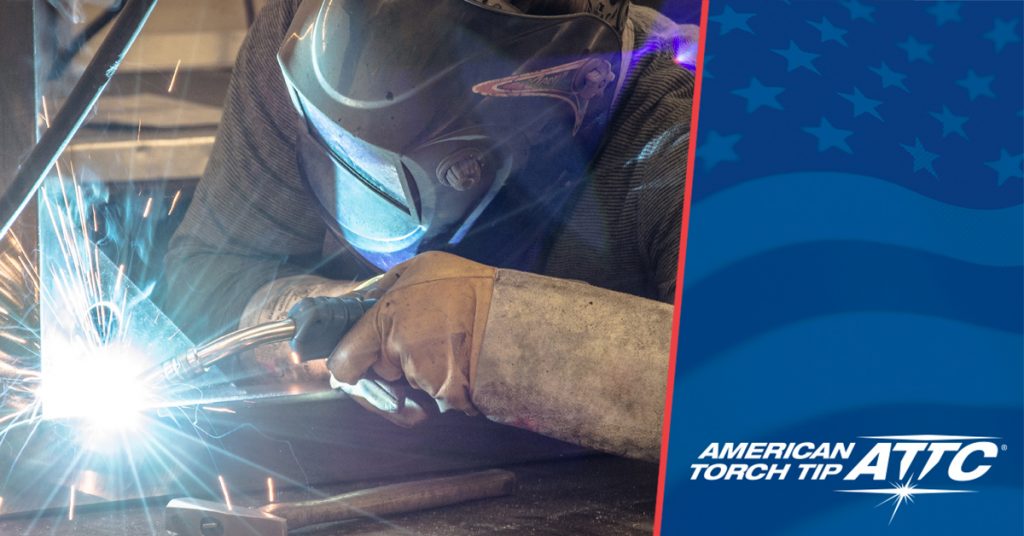

Aluminum is a popular material used in various industries due to its lightweight, strength, and durability. However, welding aluminum can be a challenging task for welders due to its unique properties. Gas Metal Arc Welding (GMAW), also known as MIG welding, is a commonly used welding process for aluminum.
Welding Aluminum Using the Gas Metal Arc Welding Process
The GMAW process utilizes a continuous wire electrode and a shielding gas to protect the weld from contaminants. In this blog post, we will explore the basics of welding aluminum using the GMAW process, including techniques, materials, and safety considerations.
Aluminum Preparation
To successfully weld aluminum, the welder should always take care to clean the base material and remove any aluminum oxide and hydrocarbon carbons that contaminate the surface of the material. Aluminum oxide on the surface of the material melts at 3,762° F (2,072°C), and the aluminum base metal melts at 1,221° F (660.3°C). Leaving any oxide on the surface of the base material will reduce penetration of the filler metal into the workpiece.
To remove aluminum oxides, use a stainless-steel wire brush only. Using a steel brush will contaminate the base metal by imbedding carbon into the aluminum. Another way to clean aluminum is to use cleaning solutions that are available through most welding distributors and industrial supply companies.
When using chemical etching solutions, make sure to remove them from the work before welding. To minimize the risk of hydrocarbons from oils or cutting solvents entering the weld, remove them with a degreaser. Check that the degreaser does not contain any hydrocarbons.
Pro tip: If you think the base material is clean, clean it again.
Preheating Aluminum
Preheating the aluminum workpiece can help avoid weld cracking. The preheating temperature should not exceed 230° F (110° C). Typically, welding only requires preheating when welding on thick materials. It can also aid the welder when welding a thin section to a thicker section.
Another factor of consideration is the joint design. For example, a bevel should be reconsidered when welding plates in the flat position may be a better choice.
Welding wire
There are several different grades and sizes of aluminum welding wire. 4043 and 5356 grade weld wire are the most common, however there are several other grades that are application and base metal specific. Always consult the manufacturer on which grade is best for the base metal being welded. There are several wire selection guides available on the internet.
Shielding Gases
Shielding gas is used to shield the weld puddle from outside contaminants. The most common shielding gas for welding aluminum is 100% argon due to its thorough cleaning abilities and penetration profile. When welding thicker sections of ½” or greater, a mixture of 75% helium and 25% argon is commonly used due the fact that it creates a hotter arc and aids in penetration.
Weld Gun Angle
With aluminum, using a push angle rather than a pull angle will result in better cleaning action, reduced weld contamination, and improved shielding-gas coverage.
Travel Speed
Welding aluminum dictates the use of hotter amperage and voltage setting compared to steel, along with higher travel speeds. If travel speed is too slow, the welder risks excessive burn through, particularly on thin-gage aluminum sheet.
Convex-Shaped Welds
In aluminum welding, crater cracking causes most failures. Cracking results from the high rate of thermal expansion of aluminum and the considerable contractions that occur as welds cool. The risk of cracking is greatest with concave craters, since the surface of the crater contracts and tears as it cools. Therefore, welders should build-up craters to form a convex or mound shape. As the weld cools, the convex shape of the crater will compensate for contraction forces.
While MIG welding aluminum may present some challenges which require a little more skill to produce quality welds compared to steel, a little practice and the right equipment goes a long way.
Trust American Torch Tips For Your Welding Needs
It’s no secret that manufacturers and welders require top-quality welding and cutting equipment to ensure precise and efficient operations. That’s why American Torch Tip (ATTC) prides itself in its high-performance welding and cutting solutions. ATTC offers a wide range of products, including MIG, TIG, and plasma cutting torches, as well as replacement parts and accessories.
With over 80 years of experience, ATTC has established a reputation for delivering exceptional quality products that meet the most demanding requirements of its customers. Moreover, our commitment to innovation and customer satisfaction has made us a reliable partner for many industries, including military, automotive, and metal fabrication.
Trusting American Torch Tip for welding and cutting needs guarantees that manufacturers and welders receive the best quality products and support, resulting in higher productivity and profitability.
Sign up for our Monthly Newsletter
Join our community of over 20,000 industry experts and subscribe to our newsletters to receive product announcements and offers.